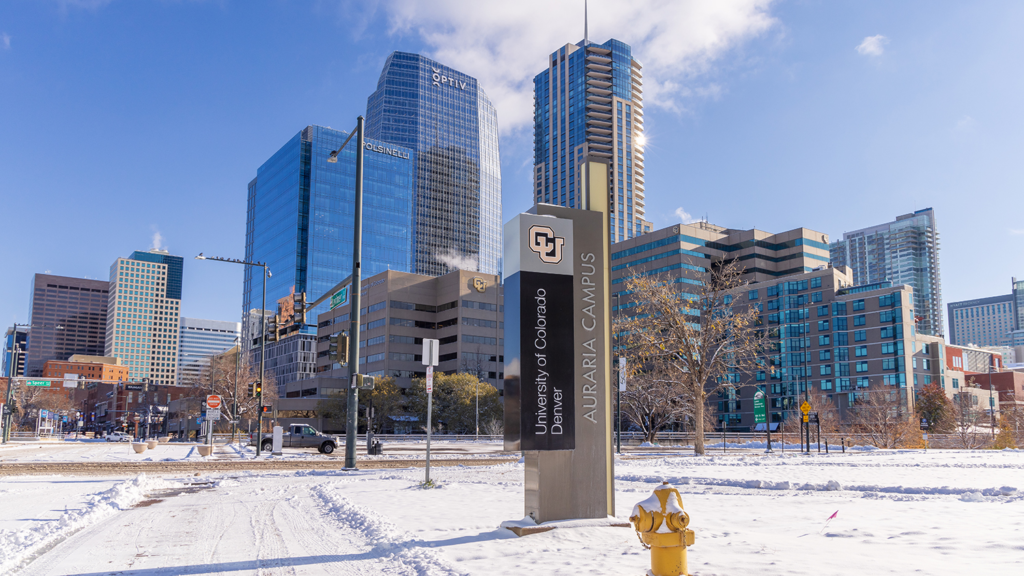It is time to break out the balloons and confetti for the golden anniversary of one of the best kept secrets in Colorado higher education. The University of Colorado Denver is turning 50 this year. CU Denver, not to be mistaken with its Boulder counterpart, shares the sprawling Auraria campus with two other gems in the state’s higher educational system, Metropolitan State University Denver and Community College of Denver. CU Denver, having set down roots on the site in 1973, is the ‘new kid’ on the Auraria campus.

The CU in the city experiment began quietly enough in 1939 with what was then called the Denver CU Extension at 509 17th Street. One full-time faculty member ran the entire operation. Over the years, a single room and a single instructor have grown exponentially.
In various phases the school expanded to an entire building—the building now known as the Hotel Teatro at 14th and Arapahoe. But in 1977 things really took off when it moved to the Auraria Campus, an entity that has been evolving all on its own.
But it was 1973 when the CU Board of Regents officially renamed the school the University of Colorado at Denver. It has not only grown ever since but has become the school of choice for thousands of students. The University offers 41 bachelor’s degrees, 59 master’s degrees and 14 doctoral degrees. It also has 76 certificate programs offering career enhancements.
Also, in 2022, CU Denver was admitted to the Alliance of Hispanic Serving Universities. To win that designation, a university must serve a full-time undergraduate student population of 25 percent. Like Disney’s Buzz Lightyear, the future for CU Denver rings loud: “To infinity and beyond!”
“CU Denver’s future is tied to the city and its diverse people,” said CU Denver Chancellor Michelle Marks. “For 50 years, we have worked to prepare all students to contribute to Denver’s growing economy and benefit its many communities.” The school’s future, as outlined in its 2030 Strategic Plan, “is to make education work for all…ensuring that all students of all backgrounds get the kind of education and hands-on experiences that will not only lead to their success, but that will also continue to elevate our communities and this city.”
One program that reaped the benefits of CU Denver’s evolution has been the College of Architecture and Planning, said former faculty member, Professor Phil Gallegos. The former Puebloan and Notre Dame graduate, Gallegos began teaching at CU Denver in 1983 with stops in between at the University of Hawaii and University of New Mexico. When he arrived at the school, he said his first impression was one of a program with only scant diversity, either ethnic or gender in both faculty and students. Beyond teaching, Gallegos said he committed to creating an environment of a changing society.
At first, with little rank and certainly far from tenure, he said, “There was not much I could do.” What he did know is that he, as a Latino, couldn’t be the rarity among Latinos with a desire to build and create. As he became more experienced and with the environments he encountered at programs at both Hawaii and New Mexico, he knew he could accelerate change.
Gallegos said he was given the green light to recruit both faculty and students to the program. “I was amazed to see the number of transfer students coming in,” he said. “They were coming in from all over the nation.” New students, he said, were coming from age groups he hadn’t seen in the program, including veterans. They were also coming from cultures previously underrepresented. The department was finally reflecting a 21st century American demographic.
Gallegos said students were graduating and matriculating on to some of the most prestigious graduate programs in the country. University of Texas Austin, University of Chicago, Pratt Institute and Yale, he said, were now recruiting CU Denver.
The CU Denver experiment has morphed into the CU Denver experience for thousands of students over the last half century, especially demographically. The idea of the school being a designated Hispanic Serving University may not even have occurred to anyone fifty years ago. Today, the designation is one of its selling points.
Jennifer Woodruff, CU Denver’s Director of Public Relations & Integrated Media shared a list of efforts that has become a source of pride for the school as it moves to capitalize on the region’s rich history and demographic motherlode. Among these efforts: providing programs, events and workshops that raise awareness about social justice, building community and a sense of belong for all Latinx students, faculty and staff, supporting the mentor- ship and funding for the Society of Hispanic Professional Engineers and working with faculty to support its efforts to increase Latinx Students and the infusion of cultural relevance in the curriculum.
Also, because of the displacement of families when the Auraria campus went from an idea to a reality necessitating relocating, CU Denver continues to provide its Displaced Aurarian Scholarship Program to direct descendants in perpetuity.




